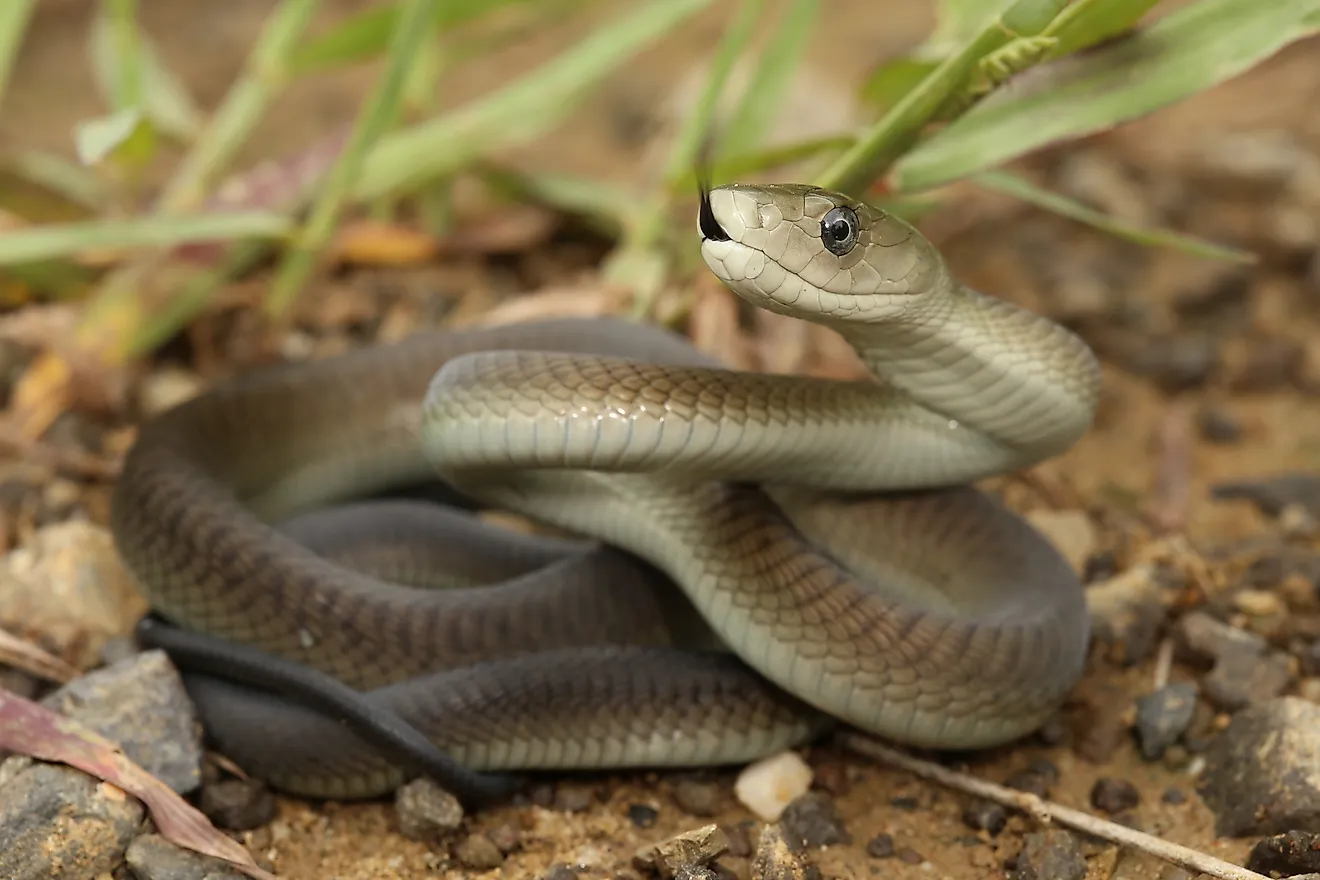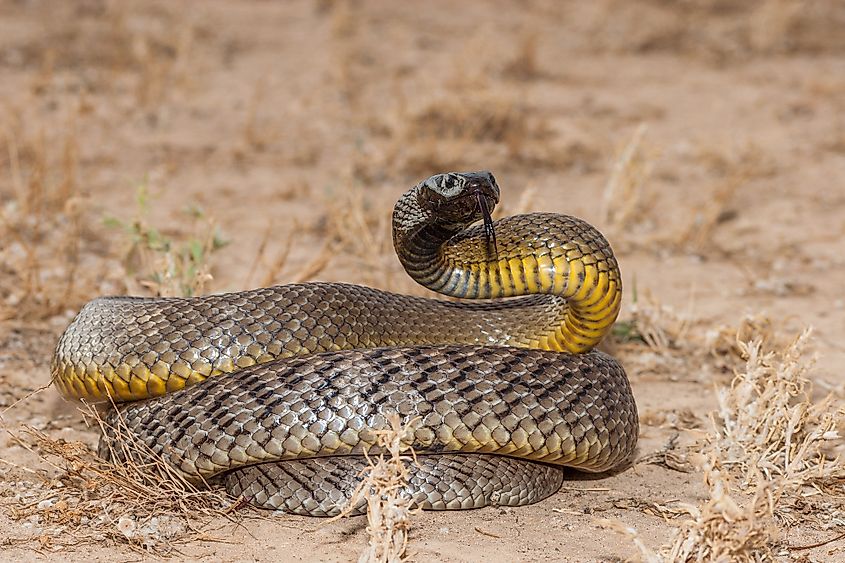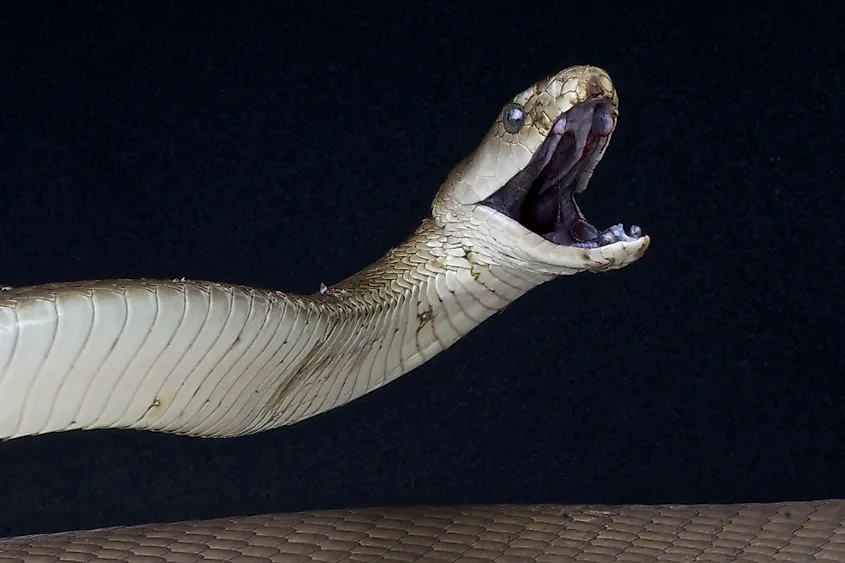Inland Taipan Vs Black Mamba: Who Is More Deadly?

- Frederick McCoy, an Irish paleonntologist, zoologist, and museum administrator first described the inland taipan.
- Black mamba is endemic to Africa.
- Inland taipan is endemic to Australia.
Animals come equipped with varied forms of defense and offense features. Be it strong, menacing horns of the buffalo, the sharp claws and the 3-inch-long canines of the cat family, the sharp regenerating teeth of the shark, or the venom of snakes. Animals have perfected the art of destroying their threats with precision. Animals that possess venom are often regarded as the most dangerous with some so potent that they kill within minutes. In the snake world, two members stand out for their lethal venom, the Inland Taipan, and the Black Mamba. However, it is difficult to clearly distinguish who is deadlier than the other as we shall see below.
The Inland Taipan

Considered among the most venomous snakes in the wild, the inland taipan belongs to the family Elapidae and is mostly found in semi-arid regions of Australia. The snake was first described in 1879 by Fredrick McCoy but has been a mystery since then. It is a rare snake that is hardly sighted by humans. It is said that a single bite of the inland taipan has enough venom to kill 100 grown men within 30 minutes if left untreated. The inland taipan is dark tan, which makes it blend well with the surroundings. The head has a round snort and is much darker than the rest of the body. The inland taipan grows to an average length of 5.9 feet with the largest one ever recorded reaching a full 8.2 feet, and its fangs range between 3.5 mm to 6.2 mm. It lays between 12 and 24 eggs, which hatch after two months. The snake can live for about 10-15 years.
The Black Mamba

The black mamba is another highly venomous member of the Elapidae family that was first described in 1864 by Albert Gunther. The name black mamba is derived from the appearance of its inside mouth that is eerily black, only seen when it is poised to attack when threatened. A mature black mamba grows to about six feet and seven inches with most spotting a grey to dark brown skin. Black mambas are found in Africa, where they prefer moderately dry environments like woodlands, semi-arid savannas, rocky outcrops, and shrubby habitats. A black mamba’s size, its speed of 10 mph, aggression, and the toxicity of its venom has made it the most feared snake on the continent. The average lifespan of the snake is 11 years. The following is a comparison between the two snakes.
Size And Distribution
When it comes to size, the black mamba beats the inland taipan hands down. At almost 7 ft long, the black mamba is among the largest snakes in Africa, and the inland taipan grows to about 5.9ft, which makes it big all the same, but still smaller than the black mamba. In terms of distribution, the inland taipan is mostly confined to the eastern half of central Australia. On the other hand, the black mamba is distributed across Africa from as far as West Africa to Southern Africa.
Venom Toxicity
The inland taipan is considered the most venomous snake in the world as it has the most potent venom of all. The median lethal dose of its venom is 0.025mg/kg while that of the black mamba is 0.341 mg/kg. The lower the value of LD50, the stronger is the venom of the species.
Aggression
The inland taipan can be described as a docile snake that only bares its fangs when disturbed or threatened. In many cases, it runs away from conflicts and only delivers its dangerous bite when cornered. The black mamba, on the other hand, can be aptly described as the epitome of craziness in the snake world. It attacks without provocation and will approach danger without fear. The black mamba is at its most fearsome state when threatened, it unleashes a series of bites and never relents until the victim stops moving.
Common Prey
The inland taipan preys on small rodents like rats, smaller mammals, and birds when it gets a chance. The black mamba has a broader range of prey that includes rats, mice, birds, and bats. The snake, on certain occasions, preys on other snakes with the puff adder and the cape cobra being its most preferred choices.
Interesting Facts
The inland taipan changes its body color depending on the season, it switches to a light-colored hue in the summer to prevent overheating and then reverts to dark-colored tinge in winter to avoid heat loss from the body. Black mambas are oviparous, meaning that they give birth to already mature snakes that are abandoned at birth to take care of themselves. Monitor lizards and king snakes are inland taipan’s mortal enemies in the wild. The black mamba’s natural enemy is the mongoose, and they always fight on sight. Both inland taipan and the black mamba hunt during the day, the black mamba, however, has a peculiar habit of always returning to the same spot to sleep in the evening. Black mambas have very high human mortality rates with about 20,000 every year, and the number is high because of how hard it is to get the antivenom in Africa where the snake is found. The inland taipan is part of three taipan subspecies, and the other two are the coastal taipan and the central ranges taipan. The black mamba, on the other hand, is part of four subspecies, with the other three being the Western green mamba, Jameson’s mamba, and the Eastern green mamba.
Status Of The Snakes
Both the inland taipan and the black mamba are of least concern in the ecosystem, with their populations considered to be stable and thriving. However, climate change is slowly affecting their numbers as the number of their prey continues to dwindle.











